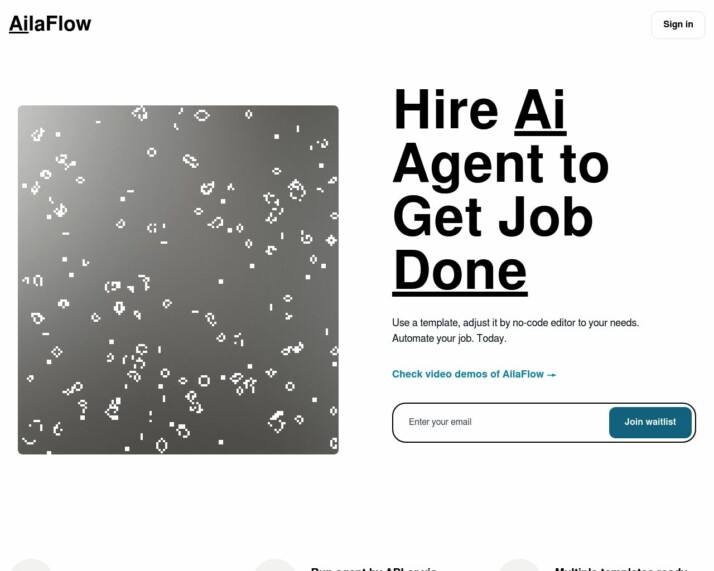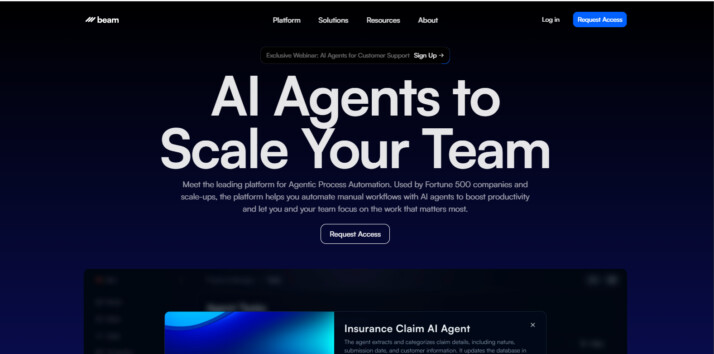AilaFlow vs. Beam AI: Which AI Agent Builder Fits Your Needs?
AI agent builders promise to revolutionize task automation and workflow efficiency. This comparison explores AilaFlow vs. Beam AI, two platforms aiming to simplify AI agent creation. AilaFlow offers a no-code approach with its visual workflow designer, making AI development accessible to non-technical users. Beam AI focuses on generative AI agents for automating repetitive tasks in areas like customer service and back-office operations. We’ll examine each platform’s strengths, limitations, and target use cases, highlighting how SmythOS emerges as a compelling alternative by combining ease of use with enterprise-grade features and unmatched scalability. Whether you’re a developer seeking powerful customization options or a business leader looking to streamline operations, this analysis will help you navigate the evolving landscape of AI agent platforms.
AilaFlow Overview
AilaFlow offers a no-code platform for building AI agents, focusing on simplicity and versatility. The platform’s core feature is a sequential workflow designer, enabling users to create AI agents without coding knowledge. This visual builder supports various applications, from graphical programming to sequence diagram editors.
AilaFlow offers a no-code platform for building AI agents, focusing on simplicity and versatility. The platform’s core feature is a sequential workflow designer, enabling users to create AI agents without coding knowledge.


The platform boasts compatibility with modern browsers and mobile devices, storing workflow definitions as JSON. It supports popular frameworks like Angular, React, and Svelte, enhancing its flexibility across different development environments. AilaFlow’s customization options include light/dark themes and full configurability, adapting to diverse user preferences.
AilaFlow’s vision centers on democratizing AI agent creation, making it accessible to users regardless of technical background. However, the platform lacks some advanced features found in other AI agent builders. It doesn’t offer hosted agents, separate development and production environments, or autonomous agent capabilities. The absence of features like memory and context management, debug mode, and multimodal support may limit its use in more complex AI applications.
AilaFlow’s vision centers on democratizing AI agent creation, making it accessible to users regardless of technical background. However, the platform lacks some advanced features found in other AI agent builders.
While AilaFlow excels in providing a user-friendly, no-code solution for basic AI agent creation, it may not fully meet the needs of users requiring more sophisticated AI functionalities or extensive integration capabilities. The platform’s strengths lie in its simplicity and visual approach, making it a potential fit for users new to AI development or those seeking quick prototyping solutions.
Beam AI Overview
Beam AI specializes in creating generative AI agents that automate repetitive tasks, boosting organizational productivity. Their Agentic Process Automations (APAs) perform functions like data extraction, customer inquiry management, and order processing more efficiently than human counterparts. These AI agents continuously learn and adapt, improving their accuracy and effectiveness over time.
Beam AI specializes in creating generative AI agents that automate repetitive tasks, boosting organizational productivity.
The platform’s no-code editor allows users to build AI agents through a visual, sequential workflow designer. This approach democratizes AI development, enabling professionals with varying technical backgrounds to create sophisticated automation solutions. Beam AI’s focus on back-office automation, customer service, compliance, and order processing makes it particularly valuable for businesses looking to streamline operations and reduce manual workload.
Beam AI’s commitment to sustainability and efficiency is evident in their approach to minimizing steps in goal achievement and reducing human carbon footprint. The platform’s emphasis on speed and customer obsession drives continuous innovation, aiming to build bigger, scale faster, and enhance user experiences. However, the platform lacks some advanced features like hosted agents, separate development and production environments, and multimodal capabilities.


Beam AI Website Screenshot
While Beam AI offers powerful tools for creating AI agents, it may have limitations in areas such as memory and context management, explainability, and debug modes. The platform does not specify features for multi-agent collaboration or human-AI interaction, which could be crucial for some complex use cases. Additionally, the absence of information on data encryption, OAuth, and IP control might raise concerns for enterprises with stringent security requirements.
Despite these limitations, Beam AI’s focus on creating a sustainable and ethical future using AI, coupled with its vision of building agents capable of tackling complex workflows, positions it as an interesting option in the AI agent builder market. Its international team’s commitment to advancing towards artificial general intelligence (AGI) reflects the platform’s ambition to remain at the cutting edge of AI technology.
Feature Comparison
AilaFlow and Beam AI offer no-code platforms for building AI agents, but differ significantly in their core capabilities. AilaFlow provides a sequential workflow designer for creating basic AI agents without coding. Its visual builder and framework compatibility make it accessible for users with limited technical skills. However, AilaFlow lacks advanced features like hosted agents, separate environments, and autonomous capabilities.
Beam AI focuses on generative AI agents for task automation, particularly in areas like back-office operations and customer service. Its Agentic Process Automations (APAs) continuously learn and adapt, improving efficiency over time. While Beam AI emphasizes productivity gains and sustainability, it also lacks some advanced features found in more comprehensive platforms. Neither AilaFlow nor Beam AI offer robust security features like data encryption or OAuth, which may concern enterprises with strict security requirements.
Feature Comparison Table
| AilaFlow | Beam AI | SmythOS | |
|---|---|---|---|
| CORE FEATURES | |||
| Visual Builder | ✅ | ❌ | ✅ |
| No-Code Options | ✅ | ❌ | ✅ |
| Debug Tools | ✅ | ❌ | ✅ |
| Multimodal | ✅ | ❌ | ✅ |
| SECURITY | |||
| Constrained Alignment | ❌ | ✅ | ✅ |
| IP Control | ❌ | ✅ | ✅ |
| COMPONENTS | |||
| Data Lakes | ❌ | ❌ | ✅ |
| DEPLOYMENT OPTIONS (EMBODIMENTS) | |||
| Staging Domains | ❌ | ✅ | ✅ |
| Production Domains | ❌ | ✅ | ✅ |
| DATA LAKE SUPPORT | |||
| Hosted Vector Database | ❌ | ❌ | ✅ |
| Sitemap Crawler | ❌ | ❌ | ✅ |
| YouTube Transcript Crawler | ❌ | ❌ | ✅ |
| URL Crawler | ✅ | ❌ | ✅ |
Best Alternative to AilaFlow and Beam AI
SmythOS stands out as the superior alternative to AilaFlow and Beam AI, offering a comprehensive AI automation platform that surpasses both in capability and ease of use. Our solution provides a robust set of features designed to streamline AI agent creation and deployment, making it the ideal choice for businesses and developers seeking powerful, flexible AI tools.
Unlike AilaFlow’s limited sequential workflow designer or Beam AI’s focus on specific back-office automations, SmythOS delivers a versatile, drag-and-drop interface that enables users to build complex AI workflows without extensive coding knowledge. This visual approach, combined with our extensive library of pre-built components and integrations, allows for rapid development and deployment of AI agents across a wide range of use cases.
SmythOS delivers a versatile, drag-and-drop interface that enables users to build complex AI workflows without extensive coding knowledge.
We’ve prioritized scalability and enterprise-grade features that AilaFlow and Beam AI lack. SmythOS offers advanced security measures, including data encryption and OAuth support, making it suitable for organizations with strict compliance requirements. Our platform also provides robust debugging tools, multi-agent collaboration capabilities, and support for various deployment options — features that are either limited or absent in AilaFlow and Beam AI.
SmythOS excels in data handling and integration, offering support for data lakes, hosted vector databases, and multi-modal inputs — capabilities not found in either AilaFlow or Beam AI. This comprehensive approach ensures that our platform can handle complex, data-intensive tasks across diverse industries, from finance to healthcare. Additionally, our scheduling and monitoring features provide unparalleled control and visibility into agent activities, enabling efficient management of AI workflows at scale.
By choosing SmythOS, you’re not just selecting an AI agent builder; you’re embracing a future-proof platform that continuously evolves to meet the changing demands of AI technology. Our commitment to innovation and user empowerment ensures that you’ll always have access to cutting-edge AI capabilities, regardless of your technical expertise. With SmythOS, we’ve made advanced AI accessible and practical for businesses of all sizes, setting a new standard in AI automation that AilaFlow and Beam AI simply can’t match.
Conclusion
AilaFlow and Beam AI offer unique approaches to AI agent development, each with distinct strengths. AilaFlow’s no-code platform and visual builder democratize AI creation, making it accessible to users with limited technical skills. Beam AI’s focus on generative AI agents for task automation shows promise for businesses seeking to streamline operations and boost productivity.
However, SmythOS emerges as the superior choice, offering a comprehensive suite of features that outpaces both alternatives. Our platform combines the ease of use found in AilaFlow with the powerful automation capabilities of Beam AI, while adding crucial enterprise-grade features. SmythOS supports hosted agents, separate development and production environments, and advanced security measures including data encryption and OAuth — addressing key limitations of both AilaFlow and Beam AI.
SmythOS truly shines in its versatility and scalability. Our platform supports multimodal interactions, enables multi-agent collaboration, and offers seamless deployment options across various channels. With over 300,000 integrations available, SmythOS provides unparalleled flexibility to fit into any workflow or tech stack. Explore our diverse range of AI-powered agent templates to jumpstart your projects and see the potential for yourself.
Ready to experience the future of AI agent development? Create a free SmythOS account today and start building without limits. Our risk-free trial allows you to create unlimited AI agents and explore our platform’s full capabilities. Deploy AI agents anywhere and revolutionize your approach to automation and AI-driven solutions with SmythOS.
Last updated:
Disclaimer: The information presented in this article is for general informational purposes only and is provided as is. While we strive to keep the content up-to-date and accurate, we make no representations or warranties of any kind, express or implied, about the completeness, accuracy, reliability, suitability, or availability of the information contained in this article.
Any reliance you place on such information is strictly at your own risk. We reserve the right to make additions, deletions, or modifications to the contents of this article at any time without prior notice.
In no event will we be liable for any loss or damage including without limitation, indirect or consequential loss or damage, or any loss or damage whatsoever arising from loss of data, profits, or any other loss not specified herein arising out of, or in connection with, the use of this article.
Despite our best efforts, this article may contain oversights, errors, or omissions. If you notice any inaccuracies or have concerns about the content, please report them through our content feedback form. Your input helps us maintain the quality and reliability of our information.
